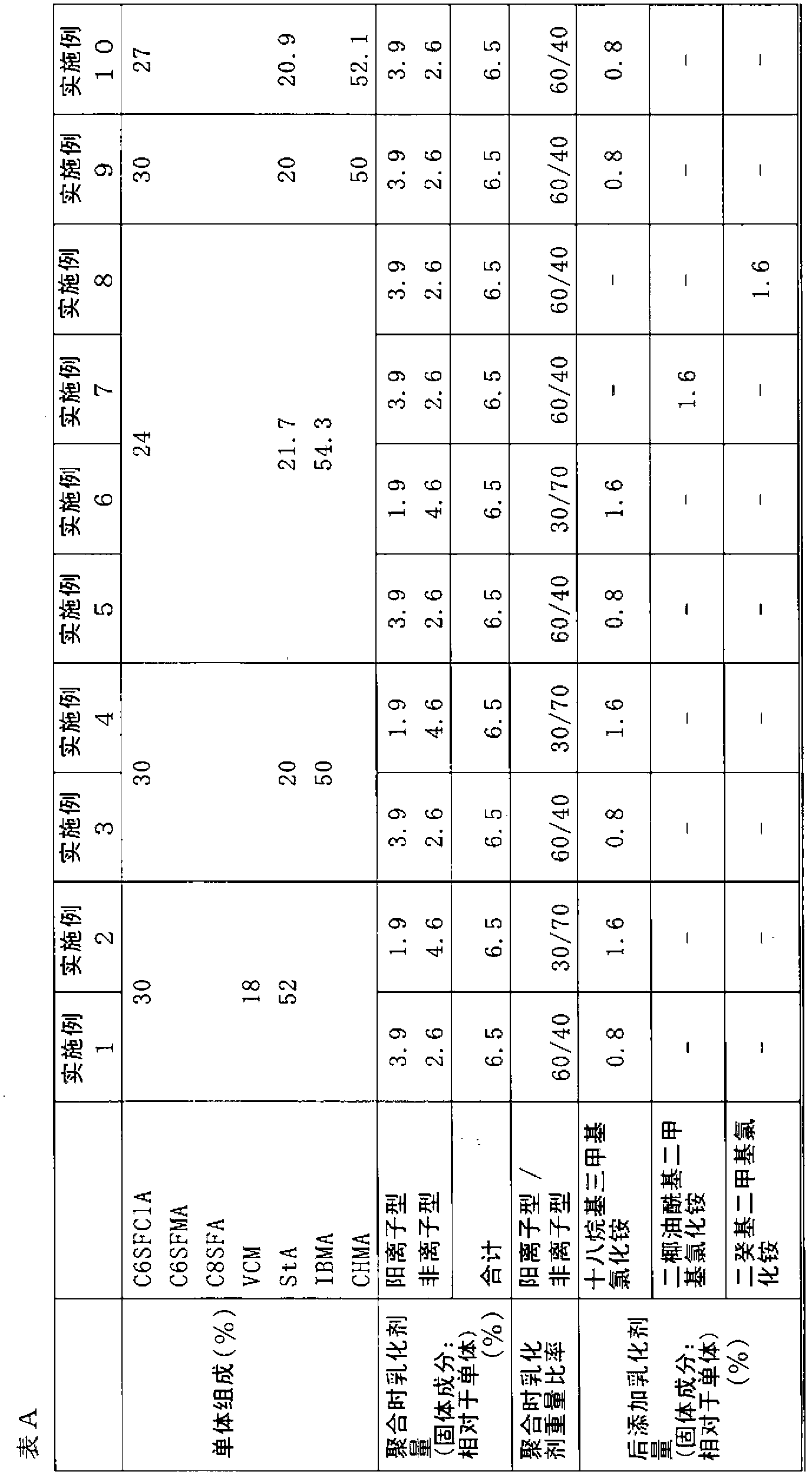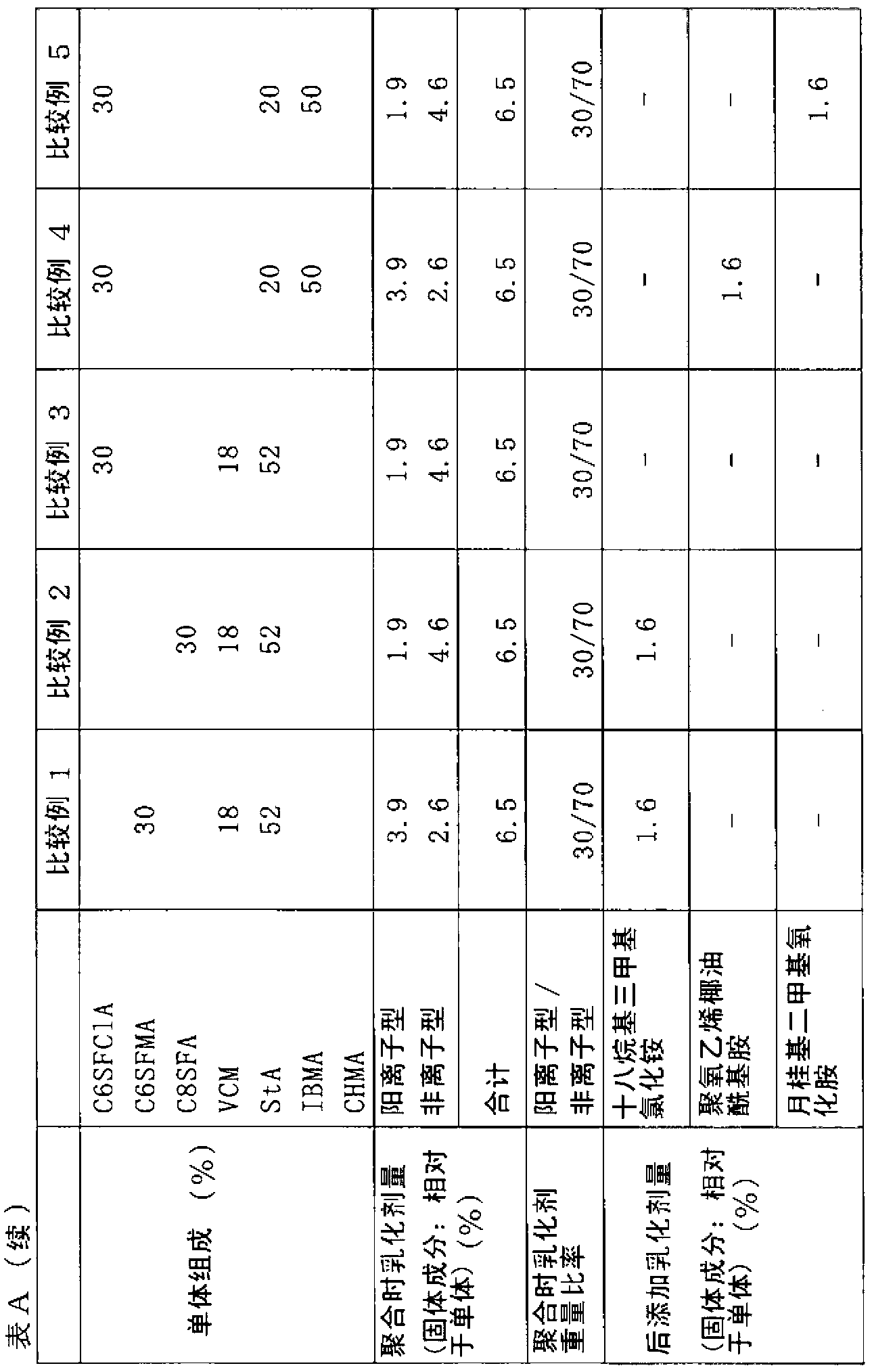Surface treating agent and manufacturing method thereof
A surface treatment agent and surfactant technology, used in fiber treatment, textiles and papermaking, and liquid repellent fibers, etc., can solve the problem of emulsifiers that have not been studied in detail, and achieve excellent water repellency and excellent dispersion stability. Effect
- Summary
- Abstract
- Description
- Claims
- Application Information
AI Technical Summary
Problems solved by technology
Method used
Image
Examples
Embodiment
[0205] Hereinafter, although an Example is given and this invention is demonstrated in detail, this invention is not limited to these Examples.
[0206] Hereinafter, unless otherwise specified, parts, %, or ratios represent parts by weight, % by weight, or ratio by weight.
[0207] The test procedure is described below.
[0208] Spray water repellency test
[0209] A spray water repellency test was performed in accordance with JIS-L-1092. The spray water repellency test is represented by water repellency No. (number) (as shown in Table 1 described below).
[0210] Use a glass funnel with a volume of at least 250ml and a nozzle capable of spraying 250ml of water in 20-30 seconds. The frame for fixing the test cloth is made of metal with a diameter of 15 cm. Three test cloths having a size of approximately 20 cm×20 cm were prepared, and the test cloths were fixed to the frame so that the test cloths were not wrinkled. Place the center of the spray on the center of the tes...
manufacture example 1
[0224] Add CF to 1L autoclave 3 CF 2 -(CF 2 CF 2 ) n -CH 2 CH 2 OCOC(Cl)=CH 2 (n=2.0) 37.25g, stearyl acrylate 64.57g, pure water 220g, dipropylene glycol monomethyl ether 37.24g, dioctadecyldimethylammonium chloride (cationic surfactant) 6.16g, Octadecyltrimethylammonium chloride (cationic surfactant) 1.74g, polyoxyethylene lauryl ether (EO: 20. EO represents the number of ethylene oxide units) (nonionic surfactant) 3.28g, poly Oxyethylene isotridecyl ether (EO: 3) (nonionic surfactant) 1.30g, polyoxyethylene oleyl ether (EO: 50) (nonionic surfactant) 0.68g, under stirring, It was emulsified and dispersed by ultrasonic waves at 60°C for 15 minutes. Add 1.24 g of lauryl mercaptan, replace nitrogen in the autoclave, press fill with 22.35 g of vinyl chloride (VCM), add 0.62 g of 2,2-azobis(2-amidinopropane) 2 hydrochloride ( Hereinafter, a solution of V-50) and 18 g of water was reacted at 60° C. for 5 hours to obtain an aqueous dispersion of a polymer. The composition...
manufacture example 2
[0226] Add CF to 1L autoclave 3 CF 2 -(CF 2 CF 2 ) n -CH 2 CH 2 OCOC(Cl)=CH 2 (n=2.0) 37.25g, stearyl acrylate 64.57g, pure water 220g, dipropylene glycol monomethyl ether 37.24g, dioctadecyldimethylammonium chloride (cationic surfactant) 3.08g, Octadecyltrimethylammonium chloride (cationic surfactant) 0.87g, polyoxyethylene lauryl ether (EO: 20. EO represents the number of ethylene oxide units) (nonionic surfactant) 5.74g, poly Oxyethylene isotridecyl ether (EO: 3) (nonionic surfactant) 2.28g, polyoxyethylene oleyl ether (EO: 50) (nonionic surfactant) 1.19g, under stirring, It was emulsified and dispersed by ultrasonic waves at 60°C for 15 minutes. Add 1.24 g of lauryl mercaptan, replace nitrogen in the autoclave, press fill with 22.35 g of vinyl chloride (VCM), add 0.62 g of 2,2-azobis(2-amidinopropane) 2 hydrochloride ( Hereinafter, a solution of V-50) and 18 g of water was reacted at 60° C. for 5 hours to obtain an aqueous dispersion of a polymer. The composition...
PUM
| Property | Measurement | Unit |
|---|---|---|
| diameter | aaaaa | aaaaa |
Abstract
Description
Claims
Application Information
 Login to View More
Login to View More - R&D
- Intellectual Property
- Life Sciences
- Materials
- Tech Scout
- Unparalleled Data Quality
- Higher Quality Content
- 60% Fewer Hallucinations
Browse by: Latest US Patents, China's latest patents, Technical Efficacy Thesaurus, Application Domain, Technology Topic, Popular Technical Reports.
© 2025 PatSnap. All rights reserved.Legal|Privacy policy|Modern Slavery Act Transparency Statement|Sitemap|About US| Contact US: help@patsnap.com


